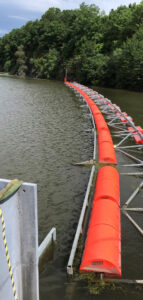Hydropower makes up more than 80 percent of the electricity produced by the New York Power Authority (NYPA), the largest state public power organization in the nation. What happens when winter ice flows threaten to clog up those critical operations? NYPA recently installed an ice boom at its Vischer Ferry small hydroelectric facility, located on the Mohawk River near Troy, New York. In this interview, the regional manager for NYPA’s Central Region, Jairo Florez, tells Hydro Leader about the need for the boom, how it was selected, and the results the facility is seeing from it.
Hydro Leader: Please tell us about your background and how you came to be in your current position.
Jairo Florez: I am originally from Colombia. I came to the United States and obtained a bachelor’s degree in electrical engineering here. I worked for Rolls Royce as a software engineer before joining NYPA in 2012. After joining NYPA, I worked as an engineer and as a manager in the operations department at the Blenheim-Gilboa Pumped Storage Power Project in Schoharie County in New York’s Mohawk Valley, focusing on dam safety and other critical NYPA initiatives. In 2018, I became operations superintendent and assumed the position of regional manager for NYPA’s Central Region last year. In my current position, I oversee the operations of the Blenheim-Gilboa Pumped Storage Power Project, NYPA’s Crescent and Vischer Ferry small hydroelectric plants on the Mohawk River, and other small power projects in the area.
Hydro Leader: Please give us some general information about NYPA.
Jairo Florez: NYPA is the largest state public power organization in the nation, operating 16 generating facilities and more than 1,400 circuit-miles of transmission lines. NYPA generates nearly 25 percent of the state’s power, and more than 80 percent of the electricity that NYPA produces is clean, renewable hydropower.

Hydro Leader: How do ice and snow affect your hydropower facilities?
Jairo Florez: In the Central Region, we face challenges associated with ice buildup at our Vischer Ferry and Crescent small hydroelectric facilities. On warmer days during the winter months, the ice layer tends to break and start moving, creating ice jams upstream of the Vischer Ferry project. We deal with big chunks of ice, up to 2 feet thick, that can clog the project’s forebays, reducing the amount of water that flows through our generating units. This forces us to reduce the units to half power to avoid unit trips. Our operators spend a lot of time raking ice. In addition to creating problems for our power plants, the ice jams can sometimes be associated with downstream flooding.
Hydro Leader: What do you do to address these issues?
Jairo Florez: We used to have an operator constantly raking ice and debris so that we could run the units at full power and avoid unit trips. This task was time consuming and required many overtime hours from our operators, particularly at the Vischer Ferry facility. Due to river dynamics, more floating ice and debris tend to flow into the Vischer Ferry intake than to that of Crescent, which is a nearly identical facility located a few miles downstream. At times, it was not possible to keep the Vischer Ferry intakes clear using the trash rake. Flow through the turbines sometimes needed to be reduced by 50 percent or more to prevent the intakes from becoming completely clogged. The result was that Vischer Ferry produced notably less power than Crescent in a typical year. That difference has been reduced with the success of the new boom.
Hydro Leader: Have you noticed any changes in ice conditions as a result of climate change?
Jairo Florez: Ice conditions for the Mohawk River still pose a challenge. There are good years when we have no ice and bad years when we have a lot. This year we have also introduced special icebreaker boats to help break the ice upstream of the Vischer Ferry project. We are encouraged by the results of this pilot project so far and are hopeful that it will help alleviate some of the challenges associated with ice-jam formation in the future.
Hydro Leader: Please tell us more about the Vischer Ferry facility.
Jairo Florez: Vischer Ferry Dam is located approximately 14 miles upstream of the confluence of the five branches of the Mohawk River with the Hudson River near the city of Troy in New York’s Capitol Region. The construction of Lock 7 and Vischer Ferry Dam was completed in 1913, and the construction of the two‑unit powerhouse was completed in 1925. NYPA purchased the two-unit powerhouse from the New York State Department of Transportation in 1984. The powerhouse was upgraded to four units in 1993. Today, the Vischer Ferry facility has four turbine generating units and a total output of about 12 megawatts, which is enough to power about 10,000 average-size homes. This hydropower-generated electricity is delivered into the state’s electric grid. It is a run-of-river plant operating 24/7 when there is water available. When there is no water available, the plant is forced to shut down. We operate the plant remotely from the Blenheim-Gilboa Power Project control room and have one operator stationed at Vischer Ferry with an 8-hour shift during the week; this person is responsible for keeping an eye on the units and making sure they run smoothly and sometimes gets called out after hours to take care of emerging issues.
Hydro Leader: You recently installed a new ice boom there. How did you decide on that solution?
Jairo Florez: The idea of installing an ice boom was discussed for many years prior to my arrival at NYPA. There were several analyses focused on the loss of generation due to unit trips or power disruptions caused by ice and debris clogging the forebay intake and the amount of overtime operators had to spend raking ice and debris. We also had trees and other debris collecting in the forebay during high-water events. Invasive water chestnuts also clog the river each year with a thick, dense mat that almost resembles algae. All of that comes down the river and clogs the strainers for the units. If there is ice accumulation, we can end up with a unit shutdown, and we have to pay overtime and get a person there to deal with it. The situation was putting a lot of strain on the operation of the facility.
To solve these persistent issues, we looped in NYPA engineering to investigate the design and installation of an ice boom. At the time, there were challenges with anchoring the boom to the concrete structure at the intake of the forebay. Later, we found an engineering company with an innovative design that satisfied our concerns. The design we ended up choosing was Worthington Products’ Boatbuster 20 heavy-duty debris and ice boom system. The boom is approximately 300 feet long and consists of 13 Boatbuster sections, each of which consists of a 6‑foot-tall debris screen backed by a tubular steel frame. Buoyancy is provided by several polyurethane barrel floats attached to each frame. The line is anchored on each end with slider-type anchors, which allow the line to rise and fall with the river and pond elevation. The boom has a vertical range of 10 feet.
Hydro Leader: You referred earlier to the need to remove trash and ice from the forebay. Do you also have to remove ice and debris from the boom?
Jairo Florez: Yes, that’s one of the challenges. The debris accumulates and sometimes stays there. We are trying to figure out a way to flush some of it out. Last winter, we had to shut the units down and let the water accumulate so that we could flush the debris out; we’re looking into better solutions.
Hydro Leader: What results have you seen from the Vischer Ferry ice boom?
Jairo Florez: We had some challenges with the initial installation of the ice boom because of high water flows. With run-of-river units, you’re at the mercy of water flows. You can have the people you need and have everything aligned, but if you don’t have the appropriate water levels, you can end up waiting for weeks at a time. Unfortunately, due to faulty installation by a third party, the first sheet of ice that came through after the boom was installed in December 2019 broke it. High river flows and ice conditions prevented us from investigating what had happened, and we had to wait until we could get divers in the water. We were able to correct the problem and reinstall the boom, but it took weeks. Last winter, the ice boom worked very well. We have seen a dramatic reduction in forced outages and time spent raking trash and ice, especially when we compare Vischer Ferry with Crescent. When you look at the time currently spent on raking trash and ice at the two facilities, there is a dramatic difference. We are no longer seeing much accumulation at Vischer Ferry because of the boom.
Hydro Leader: Do most of NYPA’s facilities have similar ice booms in place?
Jairo Florez: Right now, NYPA only has ice booms at Vischer Ferry and at its flagship plant, the Niagara Power Plant in Lewiston in Western New York. The ice boom at Niagara is much larger, but it serves the same purpose: to prevent ice from building up in the intakes and inhibiting power generation. The Niagara Plant also utilizes specialized icebreaker boats that break ice upstream of the intakes all winter long. Vischer Ferry has allowed us to make a strong business case: The boom has saved man-hours, reduced equipment wear and tear, enhanced personnel safety, increased annual plant output, and decreased forced outage hours. We will continue monitoring the boom at Vischer Ferry as ice conditions change from year to year and look into more options in the future
Jairo Florez is the regional manager for the New York Power Authority’s Central Region. For more on NYPA, visit nypa.gov.


